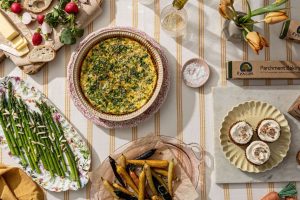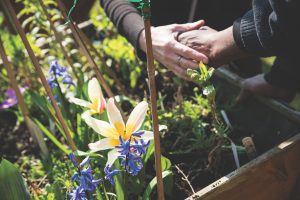How to grow your own produce (when you don’t have a garden)

If the idea of another sourdough starter makes your eye twitch, you’re not alone. The lockdown-era hobbies that once brought us comfort have, for many, faded into fond (or not-so-fond) memory. But one pursuit has quietly stood the test of time: growing our own organic food.
From cutting back on plastic packaging to lowering your carbon footprint — not to mention the joy of harvesting something you nurtured — homegrown produce is as good for the planet as it is for your plate. And, with wellness in 2025 increasingly rooted (pun intended) in sustainability, reconnecting with nature and what we eat has never felt more relevant.
So whether you’ve got a windowsill, a balcony or a full-blown allotment, growing your own herbs and vegetables is less daunting than you might think — and far more rewarding.
WINDOWSILLS
Small space? No problem.
A humble indoor herb garden is the perfect entry point for would-be growers short on outdoor space. Plus, there’s nothing quite like snipping fresh herbs straight into your supper.
-
Pot Control
“Regular harvesting helps herbs stay bushy and compact,” says Nicky Roeber, horticultural expert at Wyevale Garden Centres. Basil loves room to grow, so opt for pots around 10–15cm in diameter for most herbs. -
Let the Sunshine In
Most herbs thrive with six to eight hours of direct sun, so a bright, south-facing window is your best bet. -
Grow What You Eat
According to Jez Taylor, Head of Market Garden at Daylesford Organic, herbs like basil, mint, thyme, coriander and flat-leaf parsley are great windowsill staples. “Snipping the tips encourages them to grow back bushier — and tastier.” -
Moisture Management
Overwatering is a common pitfall. Nicky suggests the finger test: “If the top two inches of soil are dry, it’s time to water.” And keep in mind: indoor herbs have a short lifespan. Don’t expect miracles beyond a few months unless you’ve got strong sunlight. -
Go Veggie
If your windowsill is sun-drenched, try your hand at dwarf tomatoes, radishes, chillies, or even green beans. They’re compact, colourful and surprisingly satisfying.
BALCONIES
A sunny space with Juliet vibes — now with added salad.
Balconies might be best known for potted geraniums and romantic declarations, but they’re also prime real estate for growing food — if you know what you’re doing.
-
Brave the Breeze
Balconies tend to be windy, so choose sturdy, wind-tolerant plants. No divas allowed. -
Sun Seeker
Sunlight is non-negotiable for vegetables. A north-facing balcony won’t cut it — unless you’re cultivating moss. -
Pick the Right Performers
“Go for plants that keep giving,” says garden designer Jack Wallington. “Lettuce varieties and French beans offer repeat harvests, while kale and Brussels sprouts are space-hungry but productive well into winter.” -
Think Small Trees
Don’t rule out fruit. Apples and pears grafted onto dwarf rootstocks (look for M27 and Quince C) are balcony-friendly and surprisingly productive. -
Beautiful and Edible
Herbs like rosemary, sage and fennel love life on a balcony. “They’re not just useful, they’re visually lovely too,” says Jack. -
Pot Smarts
Choose pots at least 35–40cm wide to support root growth and retain moisture. Use peat-free compost and mix in slow-release fertilisers. For fruit and veg, a weekly dose of seaweed feed keeps plants nourished.
PATIOS & ROOFTOPS
A little more space? A lot more potential.
If you’ve got a sun-drenched patio or rooftop, you’re spoiled for choice. With containers, grow-bags or troughs, it’s easy to create a thriving mini market garden.
-
Top Picks
The Royal Horticultural Society (RHS) recommends: beetroot, broad beans, carrots, French beans, herbs, peas, potatoes, radishes, rocket, runner beans, chillies, peppers, salad leaves, and tomatoes. -
Berry Good News
“Blueberries and raspberries do well in pots,” says RHS Chief Horticulturist Guy Barter. “And sunny walls are perfect for grapevines or trained bramble fruits, with alpine strawberries trailing below.” -
Smart Container Choices
Terracotta looks gorgeous, but it’s thirsty — plastic or glazed ceramic pots hold moisture better. Aim for a minimum of 45cm width and depth for robust root systems. -
Water Wisely
“Pots dry out fast, especially in summer,” says kitchen gardener Kathy Slack. “Water every other day during hot spells, and if you can, feed weekly with a liquid seaweed fertiliser. It makes a noticeable difference.”
ALLOTMENTS
More space, more harvest, more joy.
No longer the preserve of flat-capped gents with flasks of tea, allotments are enjoying a millennial and Gen Z revival. They’re social, sustainable and a brilliant way to stay active.
-
Plan to Plate
“Allotments can be time-consuming,” says Jeff Barber from The National Allotment Society. “Grow what you actually want to eat. Tomatoes, courgettes and sweetcorn are perfect for plot-to-plate freshness.” -
Get More for Your Money
Soft fruits, courgettes and beans offer great value for effort. “Radishes are a great beginner crop — quick, easy and satisfying,” adds Jeff. Other cost-saving growers include asparagus, spring onions and Little Gem lettuce. -
Space It Out
Give your crops breathing room. Generous spacing means better root systems, less watering and fewer pests. Plus, it makes your plot feel more serene and manageable.








